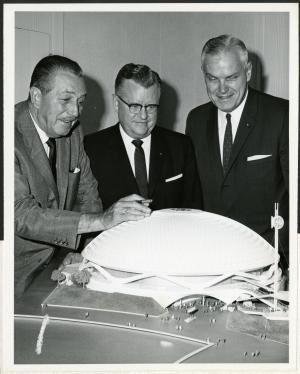 You may have heard of Disneyland, but have you ever taken a trip to Progressland? Walt Disney’s General Electric-themed vision of America’s technological future began as a model, sitting on an office desk, and ultimately became the real model for one of Disney’s theme park passion projects.
You may have heard of Disneyland, but have you ever taken a trip to Progressland? Walt Disney’s General Electric-themed vision of America’s technological future began as a model, sitting on an office desk, and ultimately became the real model for one of Disney’s theme park passion projects.
At the 1964 World’s Fair in New York, an exhibit space was included a look at America’s figurative and literal electric future. Sponsored by the General Electric Company and designed by Walt Disney, elements of "Progressland" survive today in the Disneyland and Disney World theme parks.
In this photograph from the Science Service collections at the Smithsonian Archives, Disney is pictured with an exhibit model, alongside General Electric Company President Gerald L. Phillipe and exhibits manager Steven C. Van Voorhis. Their collaboration began in 1959, when General Electric asked Disney to create an entertainment element for the company's upcoming World’s Fair pavilion about electricity and its impact on Americans, present and future. By then, Disney had considerable experience in using innovative technology to enhance his theme parks. Disneyland, which had opened in the summer of 1955, featured a jungle cruise with animatronic animals and, by 1959, had a monorail. Walt Disney’s television programs throughout the 1950s and 60s also touched on topics in technology and innovation--from space travel to the history of flight to “our friend, the atom.”
Disney’s celebrity, and his very public perception as a tech innovator, were at the forefront of General Electric’s campaign to promote Progressland. A two-page, color advertisement in a 1964 issue of Life Magazine, declared that “You’ll love Walt Disney’s magic touch at General Electric Progressland.” He is the center of the campaign--pictured standing beside a model of the eventual Progressland pavilion building, a callback in style to his television show--and is described as “America’s master showman.”
 And what show did a visitor see at the Fair? A theater where the stage stood still and the audience rotated around it--the “Carousel of Progress,” of “lifelike and animated human figures created by Walt Disney” depicting American life from the 1880s to the 1960s. A version of this World’s Fair ride is still in operation today at both Disney theme parks.
And what show did a visitor see at the Fair? A theater where the stage stood still and the audience rotated around it--the “Carousel of Progress,” of “lifelike and animated human figures created by Walt Disney” depicting American life from the 1880s to the 1960s. A version of this World’s Fair ride is still in operation today at both Disney theme parks.
Other highlights of the $17 million, three-story Progressland pavilion included demonstrations of thermonuclear fission, an “all-electric city” model ,and “a fiery story of man’s struggle to control Nature’s energy on the world’s largest projection screen” (the building’s skydome). This focus on cutting-edge electric power was a timely one in 1964. Post World War II America saw a boom in manufacturing and purchase of electric appliances. At companies like General Electric, new technology and growth meant that they had more American consumers than ever before, using more power at a lower cost. Nuclear fission was also a relatively recent development. Nuclear fission was discovered in 1938, and atomic power (and weaponry) were developed both during World War II and in the years after.
However, in reviews nationwide (from big city newspapers to local ones that often included stories of townspeople who had traveled to New York for the fair), the biggest hit of the pavilion by far was the almost-lifelike animated Disney figures. Both those technological innovations and specific exhibits would reappear throughout the Disney theme parks, such as the “It’s a Small World” ride commissioned by UNICEF and an animatronic President Lincoln.
Moreover, the World’s Fair and the Progressland pavilion inspired Disney’s plans for a new project--EPCOT (the Experimental Prototype Community of Tomorrow). Disney envisioned EPCOT as a utopian city, at the height of innovation and technology, which would positively impact the way mankind as a whole lived and worked. His vision for this space was tech-driven and forward thinking--a concept born out of Progressland.
The EPCOT theme park, finally opened 16 years after Disney's death, had evolved over the years from Disney’s original idealized concept. Both technology and culture had changed radically since the 1960s. And yet, Disney’s project was still rooted in where it really began: that model of Progressland and all the promises of electric innovation it entailed.
Related Resources
Powering a Generation, National Museum of American History
Travel Back 50 Years to 1964 New York World's Fair, Mashable
Produced by the Smithsonian Institution Archives. For copyright questions, please see the Terms of Use.

Leave a Comment